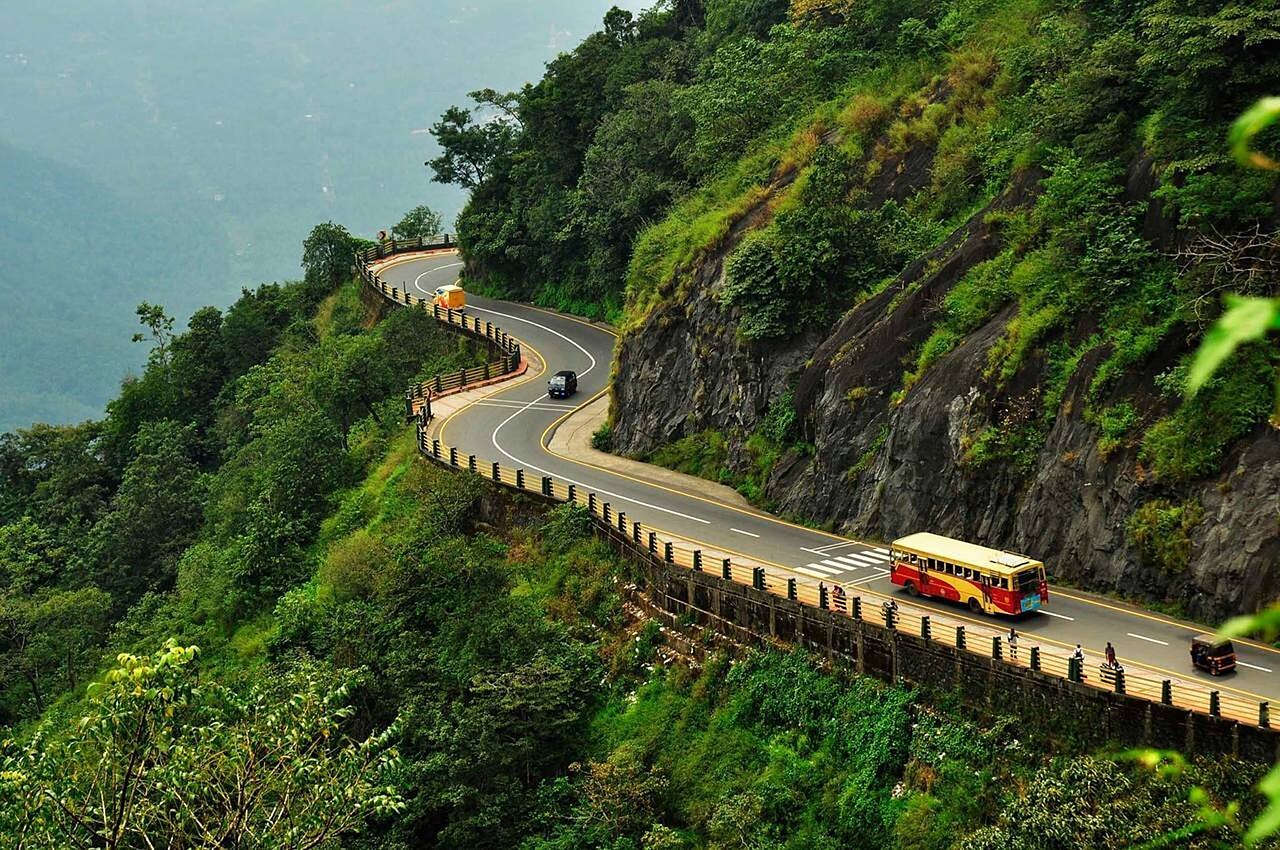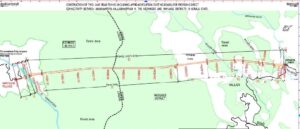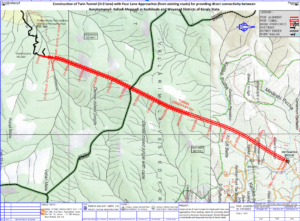Environmentalists are concerned that the planned tunnel's alignment cuts dangerously close to the Nilgiri Biosphere Reserve, falling within a 10-kilometer buffer zone known for its rich biodiversity.
Published Oct 24, 2024 | 9:00 AM ⚊ Updated Oct 24, 2024 | 9:00 AM

The tunnel project promises to cut travel time, boost tourism, and offer a crucial alternative to the often congested Thamarassery Pass. (Creative Commons)
The ambitious Anakkampoyil-Kalladi-Meppadi twin tunnel project aimed at improving connectivity between Kozhikode and Wayanad, is once again at the center of a controversy.
While the 8.735-kilometer road project promises to ease traffic between the two districts, it has drawn sharp criticism from environmental activists and local organisations.
Prominent activist Medha Patkar has raised alarms, warning that drilling through the mountain range will irreversibly harm the fragile ecosystem of Wayanad.
Adding fuel to the opposition, the Wayanad Prakrithi Samrakshana Samithi (WPSS) has renewed its fight, planning to move the High Court of Kerala against the project.
Environmentalists are concerned that the tunnel’s alignment cuts dangerously close to the Nilgiri Biosphere Reserve, falling within a 10-kilometer buffer zone known for its rich biodiversity.
As the debate intensifies, it also throws a challenge to the state government: Finding the right balance between development and environmental conservation.
Talks of an alternate route to ease traffic woes between Kozhikode and Wayanad have been ongoing since the 1970s, but the project hit multiple roadblocks due to the presence of forest lands.

The proposed Twin Tunnel (2+2 Lane) with a four-lane approach from Aanakampoyil to Meppadi in
Kozhikode and Wayanad districts. (Sourced)
In 2015, a survey commissioned by the government explored surface road construction but found it impractical. Instead, the plan for a twin tunnel, with entry and exit points on private lands near the forest, was proposed to avoid ecological concerns.
A long-pending demand, the construction of a 6.8 km twin tunnel with approach four-lane roads, connecting Anakkampoyil, Kalladi, and Meppadi, is set to revolutionise travel between Kozhikode and Wayanad.
The project, highlighted in the Social Impact Assessment report by the Centre for Management Development (CMD), promises to cut travel time, boost tourism, and offer a crucial alternative to the congested Thamarassery Pass.
The new tunnel road will link Anakkampoyil-Muthappanpuzha-Marippuzha and Meppadi-Kalladi-Chooramala roads, bypassing the forest-heavy Thamarassery route with its nine infamous hairpin bends.
Once operational, vehicles can cruise through the tunnel at speeds of 80 kmph, saving over an hour of travel time.
It is also estimated that the route will particularly benefit those travelling between Kerala, Karnataka, and Tamil Nadu, including popular destinations like Bengaluru and Ooty.
The project, estimated to cost around ₹ 2084.48 crore, will involve the acquisition of 11.1586 hectares across 18 survey numbers. The government plans to utilise this land for the construction of a bridge over the Marippuzha River, the twin tunnel, an approach road, and a temporary bridge for material transport.
The state government in a report to the Union Ministry of Environment, Forest and Climate Change emphasised the need for the proposed project, especially against the backdrop of the Kochi-Bengaluru Industrial Corridor (KBIC).
The report underlines the significance of the project in enhancing connectivity, economic development, and freight movement between Kerala and Karnataka while providing a range of direct and indirect benefits to the Malabar region.
The state government’s report identifies several essential reasons behind the project:
It will also act as a critical link between NH-766, which connects Kozhikode to Karnataka via Mysuru, and SH-59, linking Meppadi, Kalladi, and Chooramala.

The project map. (Sourced)
The seamless connectivity, the report said, will encourage industrial operations, particularly in manufacturing and tourism, by providing better access and reachability.
As the new corridor relieves traffic on existing highways, it will allow smoother movement for regional and local users. The project is also anticipated to promote the integration of underdeveloped areas in the Malabar region with the rest of the state.
The proposed corridor also aims to decongest NH-766, which currently handles most of the traffic between Kozhikode, Wayanad, and neighbouring states.
By offering an alternative route for long-distance traffic, the tunnel road will minimise congestion, reduce travel time, and cut fuel costs.
The state government in the Assembly had stated that overall, 90% of the total land required for the Anakkampoyil-Kalladi-Meppadi Tunnel Project has already been secured.
The tunnel is being constructed by Konkan Railway Corporation Limited (KRCL) with an administrative sanction of ₹2043.75 crore and a financial sanction of ₹2134.50 crore.
According to the government, Stage-1 clearance for the acquisition of 17.263 hectares of forest land was granted by the Forest Department on 31 March 2023.
The process of converting 17.263 hectares of private land into forest land—a key requirement for obtaining Stage-2 clearance—has been completed.
The certificate of entry and exit was issued by the Revenue Department and uploaded to the Parivesh portal by the Wayanad Divisional Forest Officer (DFO).
Private land spread over 16.175 hectares — including 8.0525 hectares in Kozhikode and 8.1225 hectares in Wayanad — has been acquired by the Public Works Department (PWD) and handed over to KRCL.
Efforts to acquire the remaining 1.8545 hectares of private land in Kozhikode district are currently underway, ensuring the project stays on track.
The government further stated that the final environmental clearance for the project is now under review by the State Level Expert Committee (SEAC), which is expected to give the green signal soon.
According to WPSS, the project involved several environmental and procedural issues.

The Nilgiri Biosphere Reserve Badusha is home to rich biodiversity, including critically endangered species like the Banasura Laughing Thrush. (Creative Commons)
“The PWD’s application provided incorrect information to gain initial clearance, such as denying the presence of protected areas, tribal settlements, or the need for compensatory afforestation and cost-benefit analysis,” WPSS president N Badusha told South First.
“The SEAC inspection in May 2024 flagged the high environmental sensitivity of the area, which lies in ecologically sensitive zones (ESA) and landslide-prone regions of Wayanad and Kozhikode,” he said.
Badusha further added that a letter citing the lapses was submitted to the ministry and now the organisation is planning to approach the high court against the project.
“Key aspects like the impact on water sources, biodiversity, and feasibility of constructing tunnels on unstable slopes are missing from the application. Past landslides in nearby areas, including the devastating 2019 Mundakkai landslide, were not considered in risk assessments,” he alleged.
“A misleading cost-benefit analysis was conducted, focusing only on afforestation funds, while ignoring ecological and social costs, he stated.
Badusha said the area is home to rich biodiversity, including critically endangered species like the Banasura Laughing Thrush.
Controlled blasting for tunnel construction could trigger landslides and rock failures, further endangering the ecosystem, he stated.
“Why can’t the concerned consider widening existing ghat roads on more stable slopes as an alternative,” he asked.
At the same time, Patkar, during her visit to the landslide-hit areas in Wayanad on 12 October, cautioned against large-scale infrastructure projects like tunnels.
She warned that such initiatives could lead to ecological destruction, citing Uttarakhand as an example of the environmental hazards linked to similar projects.
“Development should not come at the cost of nature or human lives,” Patkar stated during her interaction with the affected communities.
She stressed that future development efforts in Wayanad must carefully balance ecological preservation with the well-being of local communities. Patkar also mentioned her intention to take up the issue with the CPI(M) politburo.
“The politburo members have a history of supporting environment-friendly initiatives. I am confident that they will take this matter seriously and advocate for a different approach in Wayanad,” she said then.
However, Puthumala ward member Sukanyamol Ashin told South First that the locals are in support of the proposed project as it will bring development to the area.
“Some are against this project but that’s not the view of the local population. We are of the view that the tunnel road project will be of great help. In addition to connectivity, overall development of the area including tourism potential could be leveraged,” Sukanyamol said.
According to environmentalist VK Madhusoodanan, the tunnel road project stands out as a practical solution in the current scenario.
“Widening the existing roads would require the clearance of forest land, disrupting the fragile ecosystem. In contrast, the rock formations of the Western Ghats are known for their strength and stability, making them more suitable for tunneling with minimal environmental impact. However, to ensure the project’s sustainability, more comprehensive scientific studies are essential,” he told South First.
With divided opinions, a middle path, where infrastructure development coexists with nature conservation, will be crucial to avoid long-term ecological fallout in the fragile landscape of Wayanad.
(Edited by Majnu Babu).
